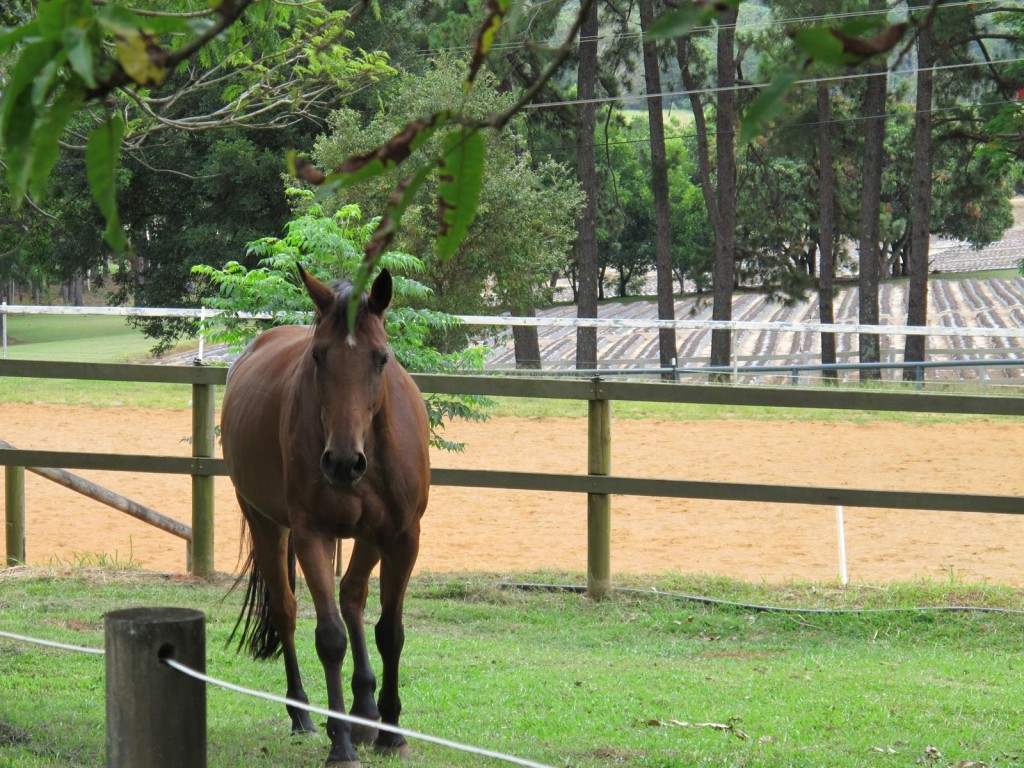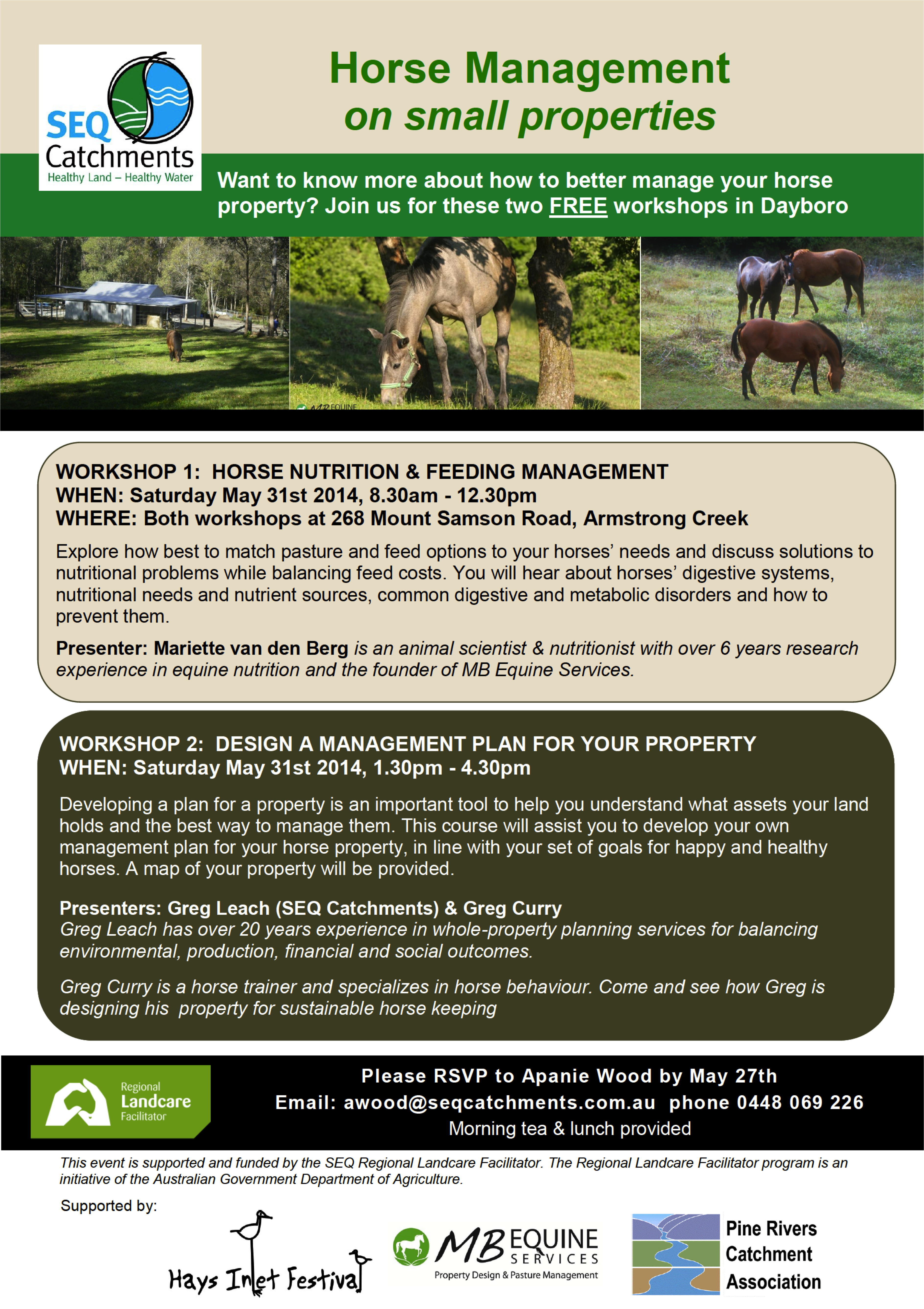Equine Nutrition & Property Planning: South East QLD @ Hays Inlet Festival May/June2014
 WORKSHOP 1: HORSE NUTRITION & FEEDING MANAGEMENT
WORKSHOP 1: HORSE NUTRITION & FEEDING MANAGEMENT
WHEN: Saturday May 31st 2014, 8.30am – 12.30pm
WHERE: Both workshops at 268 Mount Samson Road, Armstrong Creek (Dayboro)
Explore how best to match pasture and feed options to your horses’ needs and discuss solutions to nutritional problems while balancing feed costs. You will hear about horses’ digestive systems, nutritional needs and nutrient sources, common digestive and metabolic disorders and how to prevent them.
Presenter: Mariette van den Berg is an animal scientist & nutritionist with over 6 years research experience in equine nutrition and the founder of MB Equine Services.
WORKSHOP 2: DESIGN A MANAGEMENT PLAN FOR YOUR PROPERTY
WHEN: Saturday May 31st 2014, 1.30pm – 4.30pm
Developing a plan for a property is an important tool to help you understand what assets your land holds and the best way to manage them. This course will assist you to develop your own management plan for your horse property, in line with your set of goals for happy and healthy horses. A map of your property will be provided.
Presenters: Greg Leach (SEQ Catchments) & Greg Curry
Greg Leach has over 20 years experience in whole-property planning services for balancing
environmental, production, financial and social outcomes.
Greg Curry is a horse trainer and specializes in horse behaviour. Come and see how Greg is designing his property for sustainable horse keeping
http://www.seqcatchments.com.au/announcements/horse-nutrition-and-property-management-workshops

Tenterfield NSW – Equine Nutrition & Pasture Management Workshop (March 2014)
* *******UPCOMING WORKSHOP**** New South Wales:
*******UPCOMING WORKSHOP**** New South Wales:
MARCH 2014
Integrated equine nutrition & pasture management.
GRANITE BORDERS LANDCARE TENTERFIELD
Where: Showgrounds, Tenterfield NSW
When: Saturday 8th of March
Time: 8:30 am (registration) 9:00 – 3:00pm
Costs: free (inlc Morning tea/lunch)
For more information and booking contact:
Co-ordinator – Mark Thomas
PH/Fax 02 6736 3500
Mobile 0404 892 696
Email: mark@gblc.org.au
http://www.graniteborderslandcare.com.au/index.html
Program:
Integrated horse nutrition & pasture management
Healthy land = healthy horses
• Common horse & land management issues
• Horse nutrition; digestive system, feeding practices
and disorders
• Horse behaviour – time budget and foraging strategies
• Pastures; grass growth & development
• Soil development
• Ecosystem management
• Introduction to pasture/grazing planning
• Practicum: Pasture/ land inspection – observing
The Nutrition Society of Australia – Registered Animal Nutritionist
- At June 30, 2013
- By MB Equine Services
- In Equine Nutrition
 0
0
 I can now proudly announce that MB Equine Services is an official member of the Nutrition Society of Australia. In addition, I am now a Registered Animal Nutritionist in Australia and the only one in Equine!
I can now proudly announce that MB Equine Services is an official member of the Nutrition Society of Australia. In addition, I am now a Registered Animal Nutritionist in Australia and the only one in Equine!
This means that the qualifications and experiences in the field of Nutrition Science are reviewed and recognised by an independent board of medical professionals, human nutritionists, sport physiologists, animal nutritionists etc.
This organisation host a number of conferences and events for human and animal nutrition – which is a great combination. There is a lot we can gain from the Human health industry that we could apply to horses!
Research Update: Foraging behaviour in horses
 You may remember that last year we conducted a national horse forage survey for my PhD research at the University of New England. This survey was the first part of the study to collect information about foraging behaviour and diet selection of pastured domestic horses in Australia.
You may remember that last year we conducted a national horse forage survey for my PhD research at the University of New England. This survey was the first part of the study to collect information about foraging behaviour and diet selection of pastured domestic horses in Australia.
This was necessary because diet selection of fresh forages has been primarily studied in wild or free-roaming horses. Very little work has been done that looked into the diet selection of pastured horses and particular the selection of vegetation other than grasses and legumes is not documented.
In addition, we wanted to gain more insight in the pasture conditions of grazing areas, feeding management and the occurrence of unusual behaviours of horses at pasture. The data has been analysed and is now in a final draft to be reviewed and submitted to a peer reviewed journal. We hope later this year to provide a link to the official published paper and we will feature a summary of the results in the Horses and People and Hoofbeats Magazine. So stay tuned!
The next step in this research is to gain a better understanding of the motivations of selecting a wide range of forages by horses. We are aware that herbivores select a variety of plants to cover their nutritional requirements but there is also a complex feedback mechanism – so called post ingestive feedback – that is involved. Animals can get satiated on the plants they select (due to flavour or nutrients) or there may be secondary compounds that are getting to excessive and so animals may need to switch to another plant source. There are many other factors that will influence diet selection of herbivores. Only limited research has been conducted with horses, so my research will focus on getting a better insight in some of these aspects for horses.
One of the first task was collecting some novel/alternative forages for horses. Finally after 5 months we finished the collection of tree/shrub forage for the first trial. We collected between 70- 100 kg of fresh weight of Tagasaste, Bamboo and Willow leaves! Just to get about 30 kg of dried and chaffed material. The other fodder Saltbush and Moringa are already ready for us.

Now we can focus on the next stage – which is getting ready for the actual forage trial with the horses. We are interested to look at novel and familiar forages and bunch of other things that I am hoping to get more insight in! Re-visit our website/blog and/or like our MB Equine Services Facebook page to get the latest updates on this research project and other educational events such as workshops or article releases.
Mariette
Research Alternative Forages for Horses
 In 2012 I started my PhD project at the University of New England. The main focus of my study is patch foraging behaviour, particular browsing behaviour, in horses and the use of fodder trees and shrubs as forage enrichment for domesticated horses in Australia. This research will help the horse industry to better understand the potential use of alternative and suitable forage sources and the affect of forage enrichment on the behaviour of horses in intensive equine management systems.
In 2012 I started my PhD project at the University of New England. The main focus of my study is patch foraging behaviour, particular browsing behaviour, in horses and the use of fodder trees and shrubs as forage enrichment for domesticated horses in Australia. This research will help the horse industry to better understand the potential use of alternative and suitable forage sources and the affect of forage enrichment on the behaviour of horses in intensive equine management systems.
Patch foraging behaviour and animal welfare
Why this interest in patch foraging behaviour? I believe that the ability to browse on a range of trees, shrubs, herbaceous plants, roots and mosses might be important for the health and well-being of horses.
In 2009, I moved to Australia from The Netherlands and founded MB Equine Services, which provides specialised equine nutrition and horse property design and pasture management. “Designing pasture systems is part of the business,” I started to investigate the role of alternative forage sources as a drought reserve. And a bit of research made me realise that, in nature, horses browse a lot.
This raised the question: ‘How do domesticated horses cope with an enclosed environment in which there is no – or limited – access to browsing?’ Is there something in browsing that might be important for their nutrient balance or gut and dental health?”
I hope to provide some answers to these questions in my research towards a doctoral degree at UNE. “We don’t often provide our horses with the alternative foods that – in nature – are a large part of their diet,” Variety is the spice of life for herbivores – whether they are confined, or foraging on pastures or rangelands – as well as for people. Like us, they are periodically satiated by familiarity and thrive on variety.
We keep horses in a stable or a paddock without feeling obliged to enrich their lives – and edible enrichment has been shown to be the best sort. Such enrichment could address problems of abnormal behaviour and help to avoid ulcers and dental problems.”
Farmers know that planting shrubs and trees on their properties has a range of environmental and agricultural benefits, and this possible advantage for their horses could add to that list of benefits.
Research
The first stage of the research program was a survey. You may have seen it advertised or may have even participated! If so, thank you for your contribution. This survey allowed us to collect data on how horses are managed and identify if browsing is a common behaviour in domesticated horses in Australia. I am currently conducting the data analysis and writing it up for a journal publication.
The next step is to investigate some of the questions why horses select a variety of foods and when they are more likely to ingest novel and familiar foods. The novel foods will be browse fodder. To be able to answer these questions we will conduct non-invasive preference tests with horses. We will record their behaviour by video recording. The first experiment will hopefully run later this year.
So for now I am working with novel forages, collecting browse from a variety of trees and shrubs and drying them. We need a lot of fresh browse to make a chaff. So over the coming months we will collect these forages so we can dry and chaff them for our testing. I am very curious how the horses will respond.

Keep checking our website and FB page for updates! I hope later this year to give you more information about the publication of the survey and progress of the research.

Follow Us!